Vol. 18 #2 May 25, 2017: Community Storage
In This Issue
Flanigan’s Eco-Logic
Paris Agreement Signed
Community Solar Updates
Re-purposing a Block in Oakland
Iran, Denmark Co-op in Renewables
Chernobyl at 30
Rail Energy Storage
Promoting EVs in San Diego
Turning Raindrops into Electricity
Daytona: Solar in Sports
eTrees
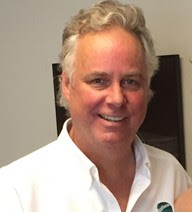
Flanigan’s Eco-Logic: Community Storage
The great new storage frontier! Since EcoMotion’s white paper on storage titled “The Lithium-Ion Revolution,” there’s been lots going on in this space for us. EcoMotion is now involved with a project using flow batteries on six school campuses in Monterey, able to provide emergency backup for seven hours, plus demand-limiting/peak shaving, energy arbitrage, and ISO services to boot… with solar! Stay tuned for EcoMotion’s upcoming white paper on “Distributed Storage and Ancillary Services.”
Now we add perspectives on storage, beginning with a new and very basic form of storage. Imagine pulling a train up high on a hill, having it sit patiently, and then letting it roll downhill during peak periods. It generates power through regenerative braking. And how about community storage, a parallel to community solar?
Throughout the course of civilization, no doubt, humans, like squirrels and bears, store provisions… be it gunpowder, pork, squash, tea, or wine. I have two friends who pay for community wine storage. Thankfully, they keep a nice inventory on hand and in perfect climate-controlled condition. It must be cost-effective… at least it tastes so!
Community storage? What? Sounds like you pay a monthly fee and get a 10*10 storage locker. But what about the “community” in “community storage?” Don’t we really mean “community energy storage,” or “community electricity storage?” What’s that all about? A place to store electrons?
Community storage builds on the notion of distributed energy storage. It brings in the element of community resources that can be shared and that provide value to the grid. Just as community solar provides a new path for solar deployment in our communities, community storage is a new and potentially disruptive way for consumers to trade in the grid of the future.
A Rocky Mountain Institute paper provides insights on how existing resources can be used as storage. In our homes, we store energy in the form of hot water, heat, cool air, some of which can be cycled and is thus a “resource” to the grid when needed. These storage opportunities are numerous and can scale quickly.
Electric vehicles have game-changing potential for community energy storage. Imagine if all EVs not in use are plugged into the grid, equipped with two-way capability. When the grid needs resources… be it capacity or frequency regulation, voltage support, etc… these “community resources” will be on call to discharge.
And community storage could work in other ways. Just as community solar arrays are being developed for community solar, large storage systems may be developed by third parties, like data centers, with their capacities sold in subscriber models. This might be an ideal way for apartment and condo owners, and homeowners who are cannot install storage at their own locations, and who have no other means of controlling their time of use, to share in a community system that provides benefits to all.
The great new storage frontier! Since EcoMotion’s white paper on storage titled “The Lithium-Ion Revolution,” there’s been lots going on in this space for us. EcoMotion is now involved with a project using flow batteries on six school campuses in Monterey, able to provide emergency backup for seven hours, plus demand-limiting/peak shaving, energy arbitrage, and ISO services to boot… with solar! Stay tuned for EcoMotion’s upcoming white paper on “Distributed Storage and Ancillary Services.”
Now we add perspectives on storage, beginning with a new and very basic form of storage. Imagine pulling a train up high on a hill, having it sit patiently, and then letting it roll downhill during peak periods. It generates power through regenerative braking. And how about community storage, a parallel to community solar?
Throughout the course of civilization, no doubt, humans, like squirrels and bears, store provisions… be it gunpowder, pork, squash, tea, or wine. I have two friends who pay for community wine storage. Thankfully, they keep a nice inventory on hand and in perfect climate-controlled condition. It must be cost-effective… at least it tastes so!
Community storage? What? Sounds like you pay a monthly fee and get a 10*10 storage locker. But what about the “community” in “community storage?” Don’t we really mean “community energy storage,” or “community electricity storage?” What’s that all about? A place to store electrons?
Community storage builds on the notion of distributed energy storage. It brings in the element of community resources that can be shared and that provide value to the grid. Just as community solar provides a new path for solar deployment in our communities, community storage is a new and potentially disruptive way for consumers to trade in the grid of the future.
A Rocky Mountain Institute paper provides insights on how existing resources can be used as storage. In our homes, we store energy in the form of hot water, heat, cool air, some of which can be cycled and is thus a “resource” to the grid when needed. These storage opportunities are numerous and can scale quickly.
Electric vehicles have game-changing potential for community energy storage. Imagine if all EVs not in use are plugged into the grid, equipped with two-way capability. When the grid needs resources… be it capacity or frequency regulation, voltage support, etc… these “community resources” will be on call to discharge.
And community storage could work in other ways. Just as community solar arrays are being developed for community solar, large storage systems may be developed by third parties, like data centers, with their capacities sold in subscriber models. This might be an ideal way for apartment and condo owners, and homeowners who are cannot install storage at their own locations, and who have no other means of controlling their time of use, to share in a community system that provides benefits to all.
Quote of the Week
“We have an idea for something which is not exactly a bus… I think we need to actually rethink the whole concept of public transport and create something that people are actually going to like a lot more. I don’t want to talk too much about it.”– Elon Musk on Mass Transit
Paris Agreement Signed on Earth Day
 On Earth Day, April 22, 2016, 175 countries signed the Paris Agreement on Climate Change at the headquarters of the United Nations in New York. The agreement had been approved by the 196 Parties to the United Nations Framework Convention of the Climate Change (UNFCCC) in COP21 in Paris on Dec. 12, 2015. The agreement will come into force once 55 countries representing at least 55% of global emissions formally join it, a process initially expected to take until 2020.
On Earth Day, April 22, 2016, 175 countries signed the Paris Agreement on Climate Change at the headquarters of the United Nations in New York. The agreement had been approved by the 196 Parties to the United Nations Framework Convention of the Climate Change (UNFCCC) in COP21 in Paris on Dec. 12, 2015. The agreement will come into force once 55 countries representing at least 55% of global emissions formally join it, a process initially expected to take until 2020.
In the Paris Agreement, countries pledge to work to limit the temperature rise overall below 2 degrees Celsius, but aim to achieve a temperature rise below 1.5 degrees Celsius. The historic agreement marked a milestone, but world leaders made it clear that more action is needed to fight a rise in global temperatures. “The world is in a race against time,” U.N. Secretary-General Ban Ki-moon said in his opening speech. “The era of consumption without consequences is over.”
Each signatory must now submit a proposed plan of action for the agreement to be effective. These plans will present “nationally determined contributions” (NDCs) of greenhouse gas emissions reductions. After each nation completes this process, the action plans will be presented to the Depositary under Ban Ki-moon in New York. It is only when an action plan has been deposited that a country has officially ratified the Paris Agreement.
Community Solar Updates
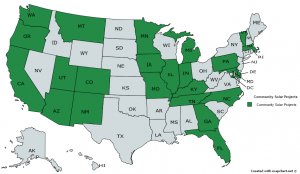
Community Solar Projects Source: Community Solar Hub
Community Solar is on a steep upward trajectory. It’s right up there with apple pie and Teslas in popularity! It just makes sense, and now the movement is a decade old.
Placed in service in 2006, the shared renewables project in Ellensburg, Washington is considered “the first community solar project in the nation.” Today there are nearly 100 community solar projects spread across America. And programs are growing up. Seattle City Light’s community solar program began by building solar systems on shade structures at city parks. Now an impressive array at the Aquarium is community owned.
In 2014, EcoMotion released a white paper on Community Solar that defined the two predominant models for deployment. Somewhat polarized in terms of ownership, access, and tariffs, these models continue to evolve, tied with net energy metering debates and the compensation rate paid for distributed generation.
In the “utility-sponsored” model the utility provides its customers with the option to purchase renewable energy from a shared facility. The customer may purchase a set amount of electricity at a fixed rate for 20 years. In the “consumer-owned” model, homes and businesses purchase panels within a larger array from a community solar provider. In turn, the consumer gets a bill credit on his or her utility bill, just as he or she would if the panels were rooftop.
According to the Solar Energy Industries Association, today there are 25 states with at least one community solar project. In total, nationally, there were 91 community solar projects with a combined capacity of 102 MW installed through early 2016.
At least 12 states and D.C. have recognized the benefits of shared renewables by encouraging their growth through policy and programs. In the next five years, the United States is expected to add 1.8 GW of community solar. That’s 27 times the cumulative 66 MW of community solar installed through 2014.
Four states are expected to install the majority of community solar over the next two years. Massachusetts, Minnesota, Colorado, and California have strong policies in place to support community solar development. In these “regulated states,” utilities are mandated to provide community solar and allow access to third party community solar developers. That said, at least one developer has found that working in states without requirements can result in superior partnerships with willing utilities and communities.
In September of 2013, the California legislature passed and the Governor signed Senate Bill 43, the Community Solar Bill. It mandated 600 MW of community solar developments.
In late January 2015, the California Public Utilities Commission (CPUC) approved the “Green Tariff Shared Renewables Program (GTSR),” as SB 43 compliant, a measure that will give millions of California residents and businesses the chance to buy fully green power. The Green Tarfiff/GTSR decision directs the three largest investor-owned utilities to offer a 100% renewable energy option to their customers, which they can do by developing 500 kW – 20 MW solar arrays from which they can sell power at a premium.
Now the community solar programs are rolling out: PG&E is now offering its Solar Choice community solar program. It has signed eight contracts for 50 MW of community solar arrays. PG&E’s program charges consumers a premium for community solar, 3.58, 2.8, and 2.85 cents per kWh for residential, commercial, and large commercial kilowatt-hours… much like a green pricing program. In this way the utility claims to avoid solar cross subsidies.
Southern California Edison is rolling out two programs for customers. First is a green tariff. Second is the Enhanced Community Renewables program through which SCE customers will buy shares of solar plants built by third-party developers. These aggregators must first win rights to offer community solar to Edison customers, then they will develop 500 kW – 3 MW community solar plants and sell shares in them for 20 – 50 year periods. Los Angeles Department of Water and Power, while exempt from the mandate, is also preparing both a “Rooftop” and “Roofless” community solar program approach.
Meanwhile, community solar programs are in ways being eclipsed by the notion and promise and now reality of Community Choice Aggregation (CCA) options.
Re-purposing a Block in Oakland

Houses on the Oakland Eco-Block
From the end of the Civil War to the Great Depression, urban expansion in the U.S. occurred through a development pattern of gridded streets and blocks, serviced by the streetcar. These first-ring, “streetcar suburbs” constitute 30% of U.S. urban-suburban residential stock today. These neighborhoods represent a huge opportunity to create greater urban sustainability and resilience at a distributed, fine-grain scale.
The Eco-Block is an urban sustainability experiment. It’s bringing together Oakland residents with a hot-shot, multi-disciplinary team of urban designers, engineers, social scientists, and policy experts from Berkeley, Lawrence Berkeley Labs, NASA Ames Research Center, Stanford, local non-profits, grassroots organizations, PG&E, EBMUD, the City of Oakland, and the State of California.
The Eco-Block project will apply a whole-systems design approach to retrofitting the block from a high energy and water dependency to the lowest energy and water footprint possible. The idea is to transform an obsolete, resource-wasteful model into an integrated design that guarantees long-term sustainability. Its proponents claim that retrofitting on the block-scale is more efficient and cost-effective than the individual house-scale.
Eco-Block will involve “the systematic re-purposing of 28 contiguous houses in a block” situated in Oakland’s northwestern Golden Gate neighborhood. When complete, the model block will have numerous features: It will be linked together with a net-energy positive, shared-rooftop, solar-powered DC microgrid with advanced energy storage. The block will also have 28 shared-electrical vehicle (EV) charging stations. Fast chargers will accelerate EV use; car sharing will add to sustainable mobility.
Eco-Block targets 40% water savings from grey-water recycling system in sinks, showers, and washing machines; plus rainwater harvesting and water-saving fixture retrofits. Eco-Block features a solar-powered bio-digester that recycles all household “black water,” and provides topsoil-grade compost and recycled, nutrient-rich water to irrigate. The project includes developing organic fruit and vegetable gardens for their bounties and nourishing a local ecosystem rich in small mammals, insects, pollinators and songbirds. Eco-Block will sustain a green, cool, and pleasant neighborhood for all, helping to avert broader urban heat-island effects.
Eco-Block will be underwritten by corporate and private foundations, as well as state and federal funding. The budget is approximately $9 million. Property owners bear no cost. Eco-Block will tap state-of-the-shelf solar, water and wastewater solutions to “repurpose homes into high-performance dwellings” that are maximally efficient, comfortable and secure.
Iran, Denmark Co-op in Renewables
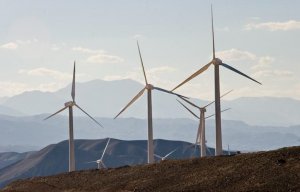
Iran’s Manjeel Wind Farm
In Spain, 25% of the nation’s power is now supplied by wind turbines. And of the wind capacity there, 20,000 MW was installed by the Danish compny, Vestas. Now Vestas wants to help Iran increase its wind energy, proposing a $100 million, 5 – 7 year investment plan that includes Vestas building a manufacturing facility in Iran to serve the Middle Eastern region.
Iran has the fourth largest oil reserve in the world and the second largest natural gas supply. The country relies on oil and gas as energy resources for 98% of its domestic needs. Of the remaining 2%, some is hydro, though its rivers are currently in drought, and there is some solar and wind. The Country has 15 wind farms already. Not surprisingly, gasoline is cheap, about 32 cents a liter; electricity costs 4.5 cents/kWh.
Iran, a “global hydrocarbon behemoth” no doubt, also has an advantageous topography for renewables. It commands a strategic location at the confluence of the Atlantic, Mediterranean, and Indian Ocean wind corridors; its northwestern and northeastern provinces reportedly experience high winds year round.
The Middle East Institute suggests that Iran has as much wind potential as Britain and France. Iran has an estimated 100,000 MW of potential. Iran’s young and growing renewables industry, guided by the Renewable Energy Organization of Iran (SUNA), is spurred on by a feed-in tariff modeled after Germany’s highly successful model, and a 10% renewable portfolio standard goal by 2020.
Chernobyl at 30

Chernobyl’s New Containment Shelter
At 1:23 a.m. on April 26, 1986, and in the midst of a routine test, there was a malfunction and an explosion that destroyed reactor No. 4 at Chernobyl’s Vladimir Illyich Lenin Nuclear Power Station in the Soviet Union. The blast threw radioactive smoke, dust, and debris into the atmosphere, where it traveled as far as Norway. It was the world’s largest nuclear accident, releasing 10 times more radiation than the catastrophic meltdown of reactors in Fukushima prefecture, Japan years later in 2011.
Thirty years later, some five million people still live on contaminated lands in Belarus, Russia, and Ukraine, and hundreds of thousands of people are sick or suffering in different ways. Some parts of Chernobyl, an area the size of Rhode Island, will not be radiation-free for 24,000 years. To this day, cancer and death toll estimates range from 4,000 to as high as one million.
There are updates at 30: Caesium-137 was one of the most widespread and dangerous of the radionuclides released at Chernobyl. During the Chernobyl explosion, about 27 kg of cesium-137 were expelled into the atmosphere. It has a half-life of 30 years. Together with caesium-134, iodine-131, and strontium-90, caesium-137 was among the isotopes distributed by the reactor explosion that constitute the greatest risk to health.
Caesium-137’s half-life of 30 years is long enough that objects and regions contaminated by caesium-137 remain dangerous to humans for a generation or more, but it is short enough to ensure that even relatively small quantities of caesium-137 release dangerous doses of radiation as it decays through “high-energy pathways.” So while one can celebrate caesium-137 at 30, much of the area must remain unpopulated for decades to come, until several more half-lives of the released cesium-137 have elapsed.
At 30, the reactor site itself is getting required attention. In the aftermath of the accident, there was a $15 billion effort to contain radiation using a concrete sarcophagus to entomb the radioactive remains. The sarcophagus wasn’t expected to last more than 30 years. In 1991, the Soviet Union broke into 15 countries. Now the site is administered by Ukraine, a country that faces the complex challenge of containing Chernobyl’s radioactive remains.
To provide a century more of protection, Ukraine, with the assistance of the European Union, has since 2012 been constructing the New Safe Confinement building. The 850-foot-wide steel shield weighs more than 30,000 tons and, at 360-feet tall could accommodate a Statue of Liberty standing up. The structure will move on tracks over the entombed reactors where it will be sealed.
It may seem strange that an area known for the deadliest nuclear accident in history has become a wildlife refuge. The Chernobyl Exclusion Zone consists of a thousand square miles that’s off limits to people. At 30 the area is now home for all kinds of animals from moose, deer, beaver, and owls to more exotic species like brown bear, lynx, and wolves. Scientists explain that without people hunting them or ruining their habitat, wildlife thrives.
Sadly, there is no mention of the long-term effects of the radiation exposure on wildlife. Wild boar there has been tested to be highly radioactive since they feed on mushrooms and truffles in the contaminated ground. Scientists have yet to test the famed Eurasian Lynx found there. It had been almost extinct in Europe for more than a hundred years. The exclusion zone has given the Lynx a haven to “thrive” in Europe once again.
Rail Energy Storage

ARES Test Track in Tahachapi, CA
Unlike other forms of energy storage, rail energy storage is incredibly simple. It relies on gravity and friction. Like pumped energy storage, it uses a height differential to create latent energy. Some call it a “cutting-edge 19th century technology.”
A Santa Barbara, California-based company, Advanced Rail Energy Storage (ARES), has developed this energy storage system. ARES’ technology uses rail cars loaded with heavy concrete blocks that are pushed to the top of a grade using excess power during off-peak hours. The rail cars then roll back down the hill, generating electricity through regenerative braking, when the grid needs energy to meet periods of high demand.
The company tested a pilot system on an 879-foot track in Tehachapi, California. ARES has recently been granted permission by the Nevada Public Utilities Commission and the Bureau of Land Management to construct a system on public land in Southern Nevada.
In the unincorporated community of Pahrump, ARES will direct a fleet of seven 8,600-ton shuttle trains up and down a 7.2% grade slope. The shuttle units will operate on a 5.7-mile track with an elevation differential of 2,100 feet. When released downhill, they will provide 50 MW of power and 12.5 MWh of energy to help stabilize the California electricity grid.
While storage costs are measured in capacity and energy, only capacity costs are presented here: Rail energy storage bears an estimated cost of $1,100/kW. That compares well with a Deloitte analysis of lithium-ion batteries in the $1,000 – 2,000/kW range. Compressed air storage costs $1,600 – 2,200/kW, pumped hydro storage costs $1,200 – 2,100/kW, and flywheel storage costs $2,100 – 2,600/kW.
Promoting EVs in San Diego
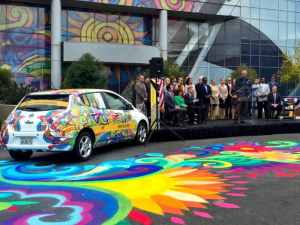
Power Your Drive Press Event
San Diego Gas and Electric (SDG&E) is taking a leadership role with electric vehicles. Now it will invest $7.5 million over the next five years on a campaign to create awareness, expand electric vehicle ownership, and lead the charge among large cities to electrify the transportation sector.
The education campaign, Power Your Drive, complements the $45 million pilot program recently approved by the California Public Utilities Commission (CPUC) to install 3,500 charging stations at 350 local businesses, multi-family communities, and disadvantaged neighborhoods. Target locations are apartments and workplaces where 10 chargers can be installed at a time. Users will be billed using SDG&E real-time rates.
The new EV education campaign will include EV ride-and-drives in every geographical area of the region, allowing customers to test drive EVs from all the major car manufacturers at one location, familiarize themselves with the benefits of driving an EV such as tax credits and rebates of up to $10,000, low “fueling” costs, and environmental protection.
Turning Raindrops into Electricity
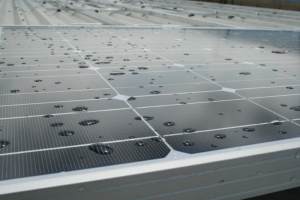 Chinese scientists have developed a solar cell with an atom-thick graphene layer that harvests energy from raindrops, making photovoltaic systems productive even on rainy days. The new solar cell can be excited by incident light on sunny days and raindrops on rainy days. These “all-weather” solar cells are “triggered” by both rain and sun, described in a paper published in the Angewandte Chemie journal.
Chinese scientists have developed a solar cell with an atom-thick graphene layer that harvests energy from raindrops, making photovoltaic systems productive even on rainy days. The new solar cell can be excited by incident light on sunny days and raindrops on rainy days. These “all-weather” solar cells are “triggered” by both rain and sun, described in a paper published in the Angewandte Chemie journal.
Rainwater clings to the graphene, forming a dual layer (also known as a pseudocapacitor) with the graphene electrons. The energy difference between these layers is so strong that it generates electricity. During the expansion of raindrops on graphene surface, the delocalized electrons can be dragged by the cations charging the pseudocapacitance.
Daytona: Solar in Sports
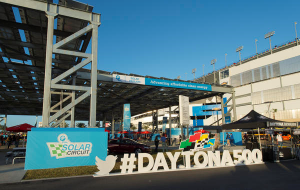
Solar Canopy at the Daytona Speedway
Florida Power & Light Company and Daytona International Speedway have recently completed the “FPL Solar Circuit,” one of the largest distributed generation installations in Florida — just in time for the Daytona 500. With a total generating capacity of 2.1 megawatts, the FPL Solar Circuit ranks the Speedway in the top five U.S. professional sports facilities for solar energy installations.
The Solar Circuit at Daytona is comprised of three canopy-like structures covered with 7,000 solar panels located at the Midway, Sprint FANZONE, and Lot 10 parking area. The power generated will prevent the emission of 2,200 metric tons of carbon dioxide each year — equivalent to an average vehicle driving more than two million laps around the speedway.
In 2007, the Colorado Rockies Coors Field was the first pro sports facility to install a solar power system (9.9 kW). In just over eight years, pro sports solar installations have grown 10 times over, with 123,000 panels installed on 37 U.S. facilities. According to a new Solar Energy Industries Association study, total solar capacity in pro sports facilities hit 21.7 MW in 2014.
SEIA’s study looked at 25 stadiums and arenas as well as 12 raceways.Topping the list is the Indianapolis Speedway, home of the Indianapolis 500. It has a 9 MW solar array. Second place is a tie between Lincoln Financial Field (home of the Philadelphia Eagles) and Pocono Raceway, with 3 MW each. Fourth is the NFL’s Washington Redskins’ FedEx Field with 2 MW. Fifth is the New England Patriot’s Gillette Stadium (1 MW). Staples Center in Los Angeles topped the list for an NHL/NBA arena with 364 kW.
eTrees
Duke Energy is testing a new streetlight that resembles an electronic tree. Charlotte, North Carolina’s pilot eTree stands on a corner opposite Bank of America Stadium, the square boughs of seven solar panels that power it leaning toward the sun. Offering LED light by night, shade by day and Wi-Fi, USB charging ports and a bench anytime, the “tree is a little oasis set in concrete.”
eTrees are made by Sologic in Israel and were featured in Paris in December. eTrees have also been installed in Europe and the Middle East. Each tree is powered by two lithium-ion batteries that can supply electricity for up to forty-eight hours.
